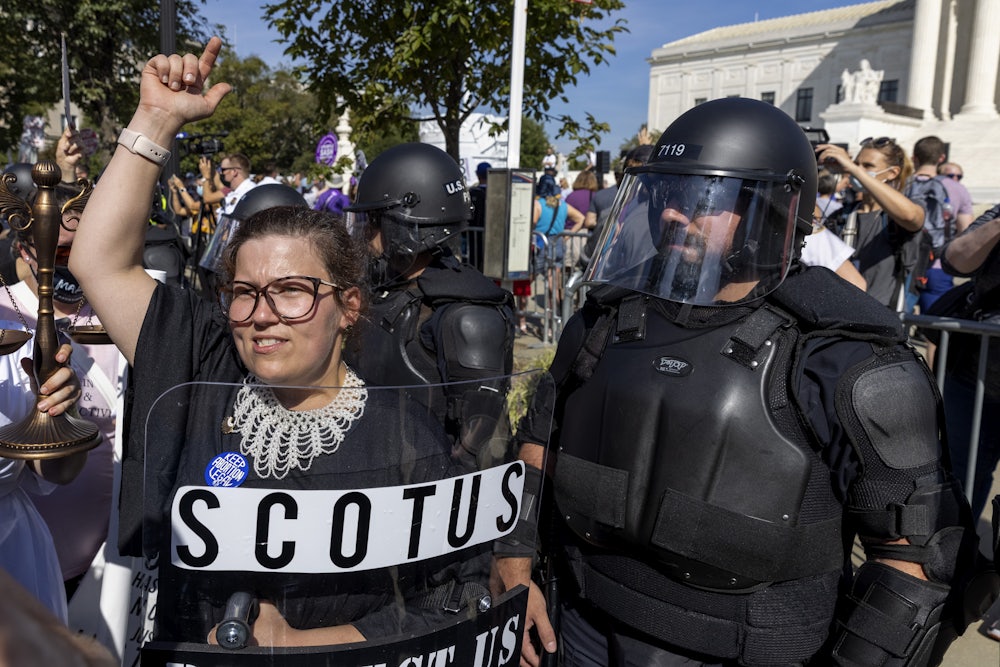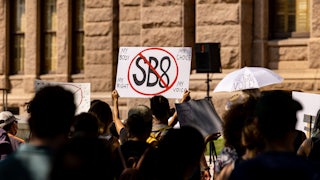Last week, the near-total abortion ban in Texas was blocked and unblocked in just under 48 hours. On October 6, federal judge Robert Pitman ordered an injunction, requested by the Justice Department, on Senate Bill 8, which bans abortions well before many people know they are pregnant. Not long afterward, the Fifth Circuit Court of Appeals, implored by the state of Texas, granted an administrative stay on Pitman’s ruling, effectively suspending it. That night, Texas Attorney General Ken Paxton, leading the war on abortion with blithe gusto, tweeted: “Great news.”
Amid this back-and-forth, abortion providers remained in limbo. As S.B. 8 went into effect, almost all clinic abortions in the state paused. The bill introduced the dystopic right for any private citizen to sue abortion providers or anyone who helps someone attain one. And while the injunction was relief—as it was for the four Whole Woman’s Health clinics that resumed services on Thursday—it was not absolute. Providers still faced the possibility of being sued retroactively. “If the injunction is knocked down in the future,” Amy Hagstrom-Miller, the founder of Whole Woman’s Health, said in a press conference less than a day before the injunction was indeed knocked down, “vigilantes could come back and sue us for every abortion we did in the interim.”
And so here we are: Today, S.B. 8 continues. Tomorrow, the Justice Department will have to respond to the Fifth Circuit. The legal battle around S.B. 8 recalls the one around Texas H.B. 2, an anti-abortion bill that was batted between courts for years before finally being struck down. This saga of a ban undone and redone, relief that was never quite relief, and indefinite uncertainty is exhausting, if familiar. Ensnared in the caprices of the law are, as usual, people who need abortions, who will have to bear the painful burden of this ban and the legal oscillations in between. Whatever unfolds with S.B. 8 should serve as a reminder: The courts alone cannot save abortion access.
While the courts can, and have, established the right to an abortion, accessing that right has become increasingly difficult in the decades since Roe v. Wade. The Hyde Amendment prevents individuals from using federal funding for their abortions, which means that millions of people are unable to use Medicaid to pay for the procedure. (Justice Thurgood Marshall, delivering the dissent in Harris v. McRae in 1980, decried the amendment for what it was and still is: “An effort to deny to the poor the constitutional right recognized in Roe v. Wade.”) At the same time, restrictions have proliferated around the country, imposing waiting periods and ultrasound requirements and forcing clinics to comply with onerous requirements or close. Many of them have. What this promulgates is a landscape of access that is inherently and startlingly uneven across lines of class, race, and geography, and will only continue to worsen.
Congressional action could be decisive. Regularly introduced since 2013, the Women’s Health Protection Act would codify the right to abortions, but Democrats have dawdled on it. As Roe faces an existential threat with a hostile Supreme Court majority gearing up to consider another abortion law out of Mississippi, the WHPA could supersede Roe’s necessity. However, the act, like most progressive priorities, would have to overcome the filibuster.
The fallacy of the right to abortion is, in some ways, the guiding principle of the reproductive justice movement, which was begun by Black women and meant to encompass those who do not fall into the image of the cisgender, white, and affluent woman for whom the “right” to abortion is currently most tenable. Reproductive justice views abortion as an intersectional concept, inextricable from economic, racial, and social justice, more than a matter of “choice” or the narrow strategy of defending Roe v. Wade.
“We want Congress to understand how their policies impact communities of color, and not just ‘women’—because when they talk about ‘women,’ what they really mean are white women,” said Marcela Howell, whose organization, In Our Own Voice: National Black Women’s Reproductive Justice Agenda helped create the Black Reproductive Justice Policy Agenda, alongside other Black-led groups. To ask for equal access to abortions, the agenda suggests, is to ask for voting rights, housing equity, education justice, safety: essentially, all the elements of a decent life.
However, a singular focus on the movement for abortion access at the national level overlooks the vibrant, optimistic network woven locally by abortion funds, which see themselves as part of the movement for reproductive justice. “We shouldn’t be waiting for federal policy to ensure our rights,” said Quita Tinsley, an advocate at an abortion fund in Georgia called Access Reproductive Care-Southeast. “We think of elected officials as having the power, but it’s the communities that have the power.”
To take a few examples: In 2019, organizers with Amplify GA and ARC-Southeast campaigned to establish a Reproductive Justice Commission for Atlanta, which will allow community members to weigh in with policy recommendations on reproductive care. Last year in Texas, the Austin Women’s Health Center led a push for increased funding for practical support for abortions (such as childcare, travel, or lodging costs) in the city budget, and won $150,000, divested from the Austin Police Department.
When S.B. 8 went into effect, the Frontera Fund in the Rio Grande Valley turned its attention to undocumented callers, who, because of their status, cannot leave border areas: Whatever abortion care Texas offers is what they can get. Just explaining the new ban “to someone calling at the moment they need us is very, very difficult,” board member Nancy Cardenas said.
After conversations across the organization about potential legal exposure under S.B. 8, the Frontera Fund’s verdict was clear: It had to keep going. “We know a lot of eyes are on Texas,” Cardenas said. With legislators in other states already introducing bills modeled after S.B. 8, Texas abortion funds’ resolve could set the model for the rest of the country. After all, the fund already isn’t exactly shy about advocating for abortions, Cardenas said, and the mission is too important: People in the Rio Grande Valley still, and will always, need abortions. “We have a saying here,” Cardenas said. “Go big or go home.”






